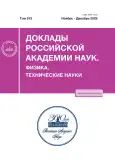MOLECULAR DYNAMIC STUDY OF THE CRATERING PROCESS DURING HIGH-VELOCITY IMPACT OF METALLIC CLUSTERS WITH A SUBSTRATE
- Authors: Utkin A.V.1, Fomin V.M.1,2
-
Affiliations:
- Khristianovich Institute of Theoretical and Applied Mechanics, Siberian Branch of the Russian Academy of Sciences
- Novosibirsk State University
- Issue: Vol 513, No 1 (2023)
- Pages: 76-80
- Section: МЕХАНИКА
- URL: https://journals.rcsi.science/2686-7400/article/view/247148
- DOI: https://doi.org/10.31857/S2686740023060135
- EDN: https://elibrary.ru/XPBKBS
- ID: 247148
Cite item
Full Text
Abstract
In the presented work, numerical experiments were carried out in the framework of the molecular dynamics method to study the impact interaction of metallic nanoclusters of different sizes with a metallic substrate in a wide range of velocities. Analysis of the obtained data showed that the crater volume remains proportional to the impact energy and inversely proportional to the dynamic strength of the material, with the direct angle coefficient being independent of the cluster size and the cluster-substrate material.
Keywords
About the authors
A. V. Utkin
Khristianovich Institute of Theoretical and Applied Mechanics, Siberian Branch of the Russian Academy of Sciences
Author for correspondence.
Email: utkin@itam.nsc.ru
Russia,
Novosibirsk
V. M. Fomin
Khristianovich Institute of Theoretical and Applied Mechanics, Siberian Branch of the Russian Academy of Sciences; Novosibirsk State University
Email: utkin@itam.nsc.ru
Russia,
Novosibirsk; Russia, Novosibirsk
References
- Златин Н.А., Красильщиков А.П., Мишин Г.И. Баллистические установки и их применение в экспериментальных исследованиях. М.: Наука, 1974.
- Bruce E.P. Review and analysis of high velocity impact data // Proc. 5th Symposium on Hypervelocity Impact. Denver, USA, 1961. P. 439–474.
- Herrmann W., Jones A.H. Correlation of hypervelocity impact data // Proc. 5th Symposium on Hypervelocity Impact. Denver, USA, 1961. P. 389–439.
- Holsapple K.A. The scaling of impact phenomena // Intern. J. Impact Engineering. 1987. V. 5. Iss. 1–4. P. 343–355.
- Denardo B.P., Summers J.L., Nysmith C.R. Projectile size effects on hypervelocity impact craters in aluminum // NASA technical note D-4067. 1967.
- Frenkel D., Smit B. Understanding Molecular Simulation: From Algorithms to Applications. Amsterdam: Elsevier Academic Press, 2001.
- Allen M.P., Tildesley D.J. Computer Simulation of Liquids. Oxford: Oxford University Press, 1987.
- Germann T.C. Large-scale molecular dynamics simulations of hyperthermal cluster impact // Intern. J. Impact Engineering. 2006. V. 33. Iss. 1–12. P. 285–293.
- Ma Xn-Ling, Yang Wei. Supersonic wave propagation in Cu under high-speed cluster impact // Nanotechnology. 2004. V. 15. № 5.
- Pogorelko V.V., Krasnikov V.S., Mayer A.E. High-speed collision of copper nanoparticles with aluminum surface: Inclined impact, interaction with roughness and multiple impact // Computational Materials Science. 2018. V. 142. P. 108–121.
- Daw M.S., Baskes M.I. Embedded-atom method: Derivation and application to impurities, surfaces, and other defects in metals // Phys. Rev. B 29. 1984. 6443. https://doi.org/10.1103/PhysRevB.29.6443
- Voter A.F. Embedded Atom Method Potentials for Seven FCC Metals: Ni, Pd, Pt, Cu, Ag, Au, and Al. // Los Alamos Unclassified Technical Report LA-UR-93-3901. 1993.
- Zope R.R., Mishin Y. Interatomic potentials for atomistic simulations of the Ti-Al system // Phys. Rev. B 68 024102. 2003. https://doi.org/10.1103/PhysRevB.68.024102
- Golovnev I.F., Golovneva E.I., Utkin A.V. Effect of the nanorod size on energy absorption at the microlevel under cyclic loading // Physical Mesomechanics. 2019. V. 22. № 5. P. 420–431. https://doi.org/10.1134/S1029959919050084
- Golovnev I., Golovneva E., Utkin A. Molecular-dynamics investigation of the initial failure of the nanosized rod under uniaxial cyclic load // Engineering Failure Analysis. 2019. V. 105. P. 672–687. https://doi.org/10.1016/j.engfailanal.2019.07.040
- Golovnev I.F., Golovneva E.I., Utkin A.V. A study into the temperature and size effects in nanostructures on their fracture under external mechanical loads // Physical Mesomechanics. 2018. V. 21. № 6. P. 523–528. https://doi.org/10.1134/S1029959918060073
- Golovnev I.F., Golovneva E.I. A study of the radius dependence of thermodynamic parameters for metal nanospheres // Physical Mesomechanics. 2020. V. 23. № 3. P. 189–192. https://doi.org/10.1134/S1029959920030017
- Golovnev I.F., Golovneva E.I. Calculation of the temperature dependence of the surface energy of metal nanoclusters in a wide range of their radii // Physical Mesomechanics. 2020. V. 23. № 4. P. 316–323. https://doi.org/10.1134/S1029959920040050
- Utkin A.V., Fomin V.M., Golovneva E.I. Parallel molecular dynamics for silicon and silicon carbide: MPI, CUDA and CUDA-MPI implementation // AIP Conference Proceedings: High-Energy Processes in Condensed Matter. AIP Publishing, 2020. V. 2288. P. 030083(12). https://doi.org/10.1063/5.0028297
- Utkin A.V. Analysis of parallel molecular dynamics for MPI, CUDA and CUDA-MPI implementation // Mathematica Montisnigri 2017. V. 39. P. 101–109. WoS: 000419276200008
- Ozhgibesov M.S., Leu T.S., Cheng C.H., Utkin A.V. Studies on argon collisions with smooth and rough tungsten surfaces // J. Molecular Graphics and Modelling. 2013. V. 45. P. 45–49.
- Herrmann W., Wilbeck J.S. Review of hypervelocity penetration theories // Intern. J. Impact Engineering. 1987. V. 5, Issues 1–4. P. 307–322.
- Shanbing Yu, Gengchen Sun, Qingming Tan. Experimental laws of cratering for hypervelocity impacts of spherical projectiles into thick target // Intern. J. Impact Engineering. 1994. V. 15. Iss. 1. P. 67–77.
- Baker J.R. Hypervelocity crater penetration depth and diameter – a linear function of impact velocity? // Intern. J. Impact Engineering. 1995. V. 17. Iss. 1–3. P. 25–35.
- Tabor D. The Hardness of Metals. Oxford: Oxford University Press, 1951.
- Tirupataiah Y., Sundararajan G. A dynamic indentation technique for the characterization of the high strain rate plastic flow behaviour of ductile metals and alloys // J. Mechanics and Physics of Solids. 1991. V. 39. Iss. 2. P. 243–271.
- Koeppel B.J., Subhash G. Characteristics of residual plastic zone under static and dynamic Vickers Indentations // Wear. 1999. V. 224. P. 56–67.
- Verkhovtsev A.V., Yakubovich A.V., Sushko G.B., Hanauske M., Solov’yov A.V. Molecular dynamics simulations of the nanoindentation process of titanium crystal // Computational Materials Science. 2013. V. 76. P. 20–26.











